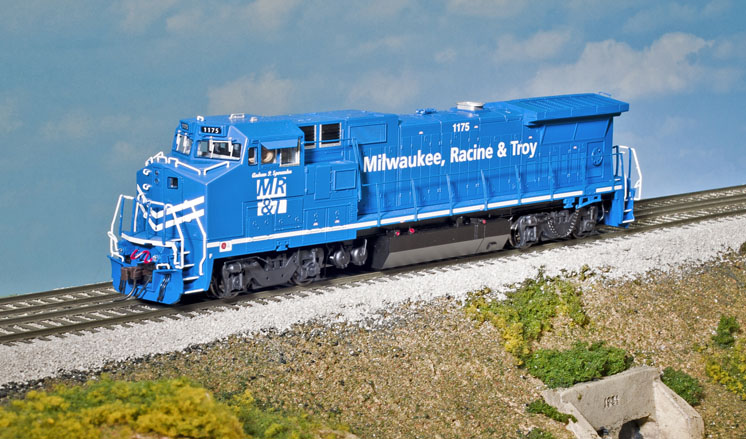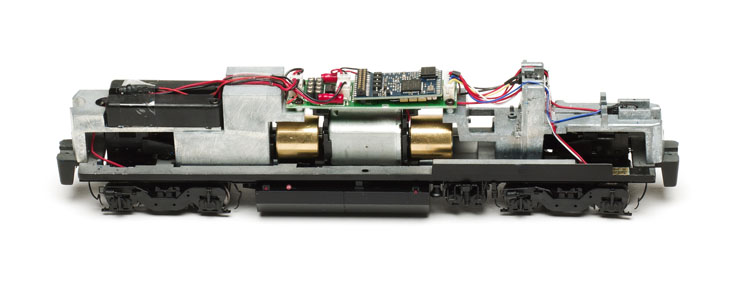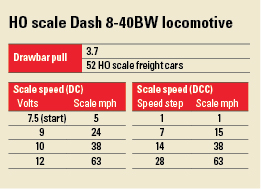In August 2001, then-associate editor Jim Hediger lauded the HO scale Atlas Dash 8-40B for its performance and detail. With this 2016 release, the locomotive is available with a dual-mode ESU LokSound Select decoder, so it sounds as prototypical as it looks on both Digital Command Control (DCC) and direct-current (DC) layouts.
Prototype. Introduced in 1988, the General Electric Dash 8-40B received many improvements over its predecessors, such as the B39-8. Enhancements included redesigned components, including microprocessors and software, as well as an improved 4,000 hp 7FDL16 diesel engine. GE built 151 Dash 8-40Bs for railroads such as Atchison, Topeka & Santa Fe; Conrail; St. Louis Southwestern (Cotton Belt); and Susquehanna. The locomotives proved especially capable leading intermodal and other hotshot freight assignments.
Beginning in 1990, the Santa Fe received the first of 83 Dash 8-40Bs equipped with a North American cab. Designated Dash 8-40BW, these units were the last four-axle GE diesels built for road-freight service. Many of these diesels, as well as the standard cab Dash 8-40Bs, are still in service.
The model. Our review sample models a Dash 8-40BW. The major dimensions of the Atlas locomotive match a prototype drawing of a Dash 8-40B in the April 1989 Model Railroader as well as official GE specifications. The model’s plastic body shell uses the same tooling as the 2001 release. The molded details are well defined and match photos of prototype Dash 8-40BWs.
The model features many separately applied details including all handrails and grab irons. Cab details include separate windshield wipers, sunshades, and painted crew figures.
The inspiration for the Atlas model’s paint scheme is the Model Railroader staff’s own freelanced HO scale railroad, the Milwaukee, Racine & Troy (MR&T). Associate editor Cody Grivno painted earlier releases of Atlas Dash 8-40B and Dash 8-BW locomotives with vintage MR&T paint schemes. (To read about Cody’s project, check out the January 2014 MR.) Our review sample models a heritage unit wearing the original MR&T scheme that adorned the road’s locomotives from 1975 to 1989.
All the white lettering is clearly printed and opaque. Our review sample, no. 1175, is extra special to the MR staff, as it has the name of our late executive editor, Andrew P. Sperandeo, printed under the cab side windows.
A powerful mechanism. After removing the couplers, I easily lifted off the plastic body shell. The can motor and flywheels are mounted in the middle of the die-cast metal chassis. Two drive shafts connect the motor to the truck-mounted gearboxes.
A printed-circuit board is screwed into the chassis above the motor. The board includes 8-pin and 21-pin DCC sockets. On our DCC-equipped sample, the ESU LokSound Select decoder is plugged into the 21-pin socket. The speaker enclosure is attached to the weight above the rear truck.
The locomotive easily handled 18″ radius curves and no. 5 turnouts. It’s drawbar pull is equivalent to 52 free-rolling HO freight cars on straight and level track. During testing on our layout, the model also sped 10 HO freight cars up a 3 percent grade without stalling.
Performance. The dual-mode ESU LokSound Select decoder provided an exceptional operating experience when run on both DC and DCC equipped layouts. The prototype could be geared for speeds up to 75 mph. The model’s 63 scale mph top speed is more than fast enough for most model railroads.
On our DCC-equipped layout I appreciated that the Dash 8-40BW already had some momentum programmed into the decoder. When I advanced the throttle, I heard the diesel engine rpm realistically increase before the locomotive started moving. When I decreased the throttle, the rpm decreased and squealing brakes sounded.
The amount of momentum, volume levels of sound effects, and every other aspect of the locomotive’s performance can be adjusted in DCC using configuration variables (CVs). I’m glad that the decoder has provision for setting up a simple three-point speed curve, in addition to a full 28-step curve. I advance consisted the locomotive with an MR&T Dash 8-40B for m.u. operation. A printed quick start guide is included, and an extensive user guide is available as a free download at www.esu.eu/en.
The decoder includes 22 user-triggered functions, such as the bell, horn, coupler crash, and dynamic brake fan. Individual function buttons control the dimmable headlight and ditch lights. The engine rpm sounds can also be manually increased or decreased (notched). Other effects simulate cab radio dialog, a talking defect detector, and sanding valves. Every function can be remapped to any throttle key.
The ESU decoder doesn’t leave out DC operators. I really enjoyed the built-in momentum when I advanced the speed control knob on our MRC Tech 4 power pack. Both sounds and lights stayed constant as long as I kept the throttle above 6V. Adding an analog sound controller, such as an MRC Tech 6, allows access to other effects.
With its powerful decoder, the Atlas Dash 8-40BW is better than ever.
Price: $279.95 (DCC sound), $169.95 (DC no sound)
Manufacturer
Atlas Model Railroad Co.
378 Florence Ave.
Hillside, NJ 07205
www.atlasrr.com
Era: 1989 to present
Road names
Dash 8-40BW: Milwaukee, Racine & Troy (blue/white, one number); Arkansas – Oklahoma (two numbers); BNSF Ry. (three numbers); and Providence & Worcester
(two numbers)
Dash 8-40B: Arizona & Eastern (three numbers); CSX (three numbers, YN3 and YN3b schemes); Milwaukee, Racine & Troy (white nose and Operation Lifesaver schemes, one number each); Minnesota Commercial
(two numbers); and Saratoga & North Creek
Features
▪▪Accumate plastic knuckle couplers at correct height
▪▪All-wheel drive and pickup
▪▪Directional light-emitting diode (LED) headlights and ditch lights
▪▪ESU LokSound Select dual-mode decoder (DCC version)
▪▪Five-pole skew-wound motor with dual flywheels
▪▪Metal RP-25 contour wheels in gauge
▪▪Minimum radius: 18″
▪▪Weight: 16.5 ounces

















Love my engine but cant get it to work in DCC